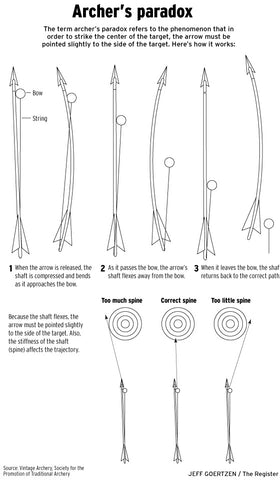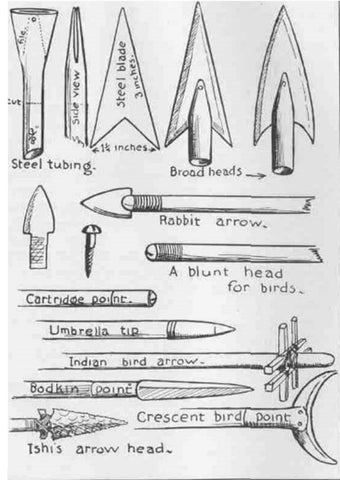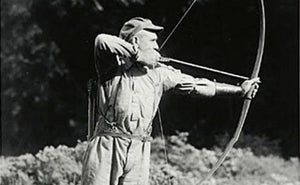“Death is like an arrow that is already in flight, and your life lasts only until it reaches you.” – Georg Hermes, German Roman Catholic Theologian, 1775-1831
The bow and arrow are a pairing, a team, each member necessary for the success of the whole. A misaligned bow will not throw an arrow true, and an arrow which is not meant for the bow may not only miss its mark, but may shatter, sending splinters deep into an archers hand or worse. Though traditional archery does not mean one must use traditional wooden arrows with feather fletching, there are common properties to be considered whether choosing carbon-fiber arrows with plastic vanes or cedar arrows with feather fletching.
Understanding The Archer’s Paradox
I had not heard of the Archer’s Paradox until after I had crafted my first bow. As I began to think about how the string aligns with the center of the bow, but the arrow is offset due to the limbs, I was perplexed as to how an arrow could ever be counted on to hit its mark. It seemed to me that an arrow, shot from a right-handed archer (resting on the left of the bow) would always veer to the left. Yet, I knew from experience that this was not the case. This phenomenon is known as the Archer’s Paradox and is key to understanding which arrows to choose and why.

Illustration of the Archer’s Paradox. Notice how a properly spined arrow will flex around the bow. This wiggling will continue until the arrow hits its mark.
Check out this short video from Smarter Every Day on the Archer’s Paradox to see it in action:
Arrow Spine
Arrow spine is the most important factor when choosing an arrow as it determines the stiffness of your arrow, and thusly the accuracy of your arrow to a large degree. Also, an arrow that is not spined to the weight of force of your bow (lbs) may shatter, which is not something you want to experience.
Thankfully, all arrows are spine tested and can be purchased based on the draw weight of your bow. The spine test is simply a compression test performed on the top and bottom ends of the arrow. The weight at which an arrow flexes and to what amount it flexes determines the spine rating. This is not to say that all arrows perform the same. Carbon fiber, aluminum, and wood arrows each have different characteristics to how they react to the archer’s paradox and each archer will decide on which type of arrow is the right blend of both expense and accuracy.
Determining Arrow Length
Finding the proper length of arrow is fairly straight forward. Simply purchase an arrow longer than you need, nock and draw the arrow and have a friend mark it about an inch from the back of the bow. That extra inch is to provide space between your fingers and the arrowhead.
Choosing Feather or Vane Fletching
Both feather and plastic vanes have their advantages and disadvantages. Once again, much of this choice comes down to how much you are willing to pay as either will make fine choices for the typical archer.
Feathers
Feathers are lighter and more flexible than plastic vanes. The primary advantage is their ability to glide through any contact with the bow, though some speculate that the tail of a properly spined arrow will not make contact with the bow (see archer’s paradox illustration above). The lighter arrow results in a faster arrow.
The disadvantages of feather fletchings is their higher cost, becoming stiff over time, and reaction to moisture, though there are dry fletching powders which can be used to prevent this. If you do not carefully store feathered arrows they can become bent. Plastic vanes may do this as well, but they generally bounce back and can be replaced quickly and easily.
Plastic Vanes
The main advantage of plastic vanes is their cost and their ease of replacement. When replacing feathered fletchings care must be taken to respect the natural bend of the feather in regards to the left or right-handedness of the archer; not so with feathers.
The disadvantage to plastic vanes is their reaction to temperature changes and lack of natural stabilization capabilities. In short, their stiffness is a disadvantage because they react more strongly to cross winds or brushes with small twigs.
Arrow Weight Considerations
As already mentioned, the weight of an arrow — measured in grains — greatly affects the speed of the arrow. However, an arrow of greater weight has more penetrating force as an object of greater mass in motion will need to be acted upon by a greater force to slow it down. I believe in physics that would be called inertia and mass. An object of greater mass has greater inertia. Anyhow, like much of archery there is a sweet spot to be found. If you want to be a target shooter you would likely use a lighter draw weight with lighter arrows. However, as a hunter, you will want heavier arrows dependent upon the game you are hunting. Each arrow has minimum weight requirements given the draw weight of the bow. Too light of an arrow will not have enough mass to absorb (or resist) the force of the string and may shatter. Too heavy of an arrow will resist the forward thrust of the string and fall short of its target.
When choosing arrows be sure to check the manufacturers chart for minimum weight, and work your way up from there.
Field Tips and Broadheads
Field tips are generally used for target practice whereas broadheads are for larger game. Archers may practice with a field tip of a certain weight, say 100 gr., and switch to a broadhead of the same weight when hunting. It is recommended to have a few broadheads for training as there is no guarantee that a field tip and broad head of the same weight will have the same accuracy. I am a fan of the Blood Runner broadheads, which expand to increase the cutting size. They also have practice broadheads so you can be sure you are training with what you plan to hunt with. However, any broadhead is likely to get the job done.
It is important to note that blunt tips were employed in archery as a typical head for hunting small game. Small points might have been used for birds, called bird-points actually, but often a rounded or bulbous style tip was used for two important reasons. Firstly, small game was hard to hit and if you missed you didn’t want your arrow getting stuck in a tree. Secondly, a puncture wound is not necessary to kill small game. A hard blow by a hard, blunt point the size of a grape could easily kill a squirrel or knock it off its perch and disorient to be killed by hand.

Various arrow-head points used by Indians. Note Ishi’s point illustrated as well.
Stay Tuned
We’ll top off the series with tips on shooting a traditional bow.


 “Death is like an arrow that is already in flight, and your life lasts only until it reaches you.” – Georg Hermes, German Roman Catholic Theologian, 1775-1831
“Death is like an arrow that is already in flight, and your life lasts only until it reaches you.” – Georg Hermes, German Roman Catholic Theologian, 1775-1831